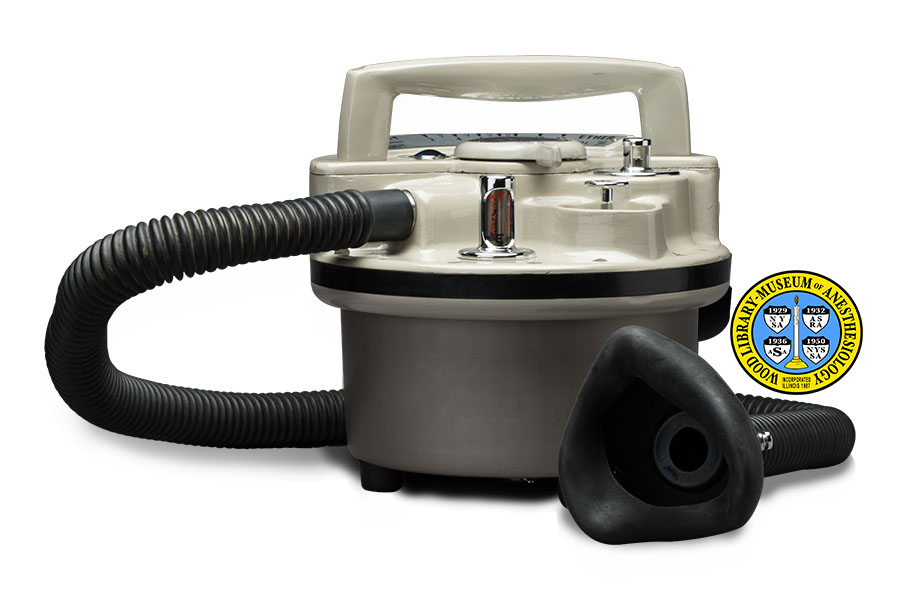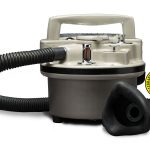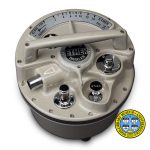Epstein Macintosh Oxford Inhaler
Epstein Macintosh Oxford (EMO) Inhaler
British anesthesiologist Sir Robert R. Macintosh (1897-1989) was the founding Chair of the University of Oxford's Nuffield Department of Anaesthetics. He and his staff worked with local manufacturers to develop new apparatus. One such company, Longworth Scientific Instrument Co., was purposely formed in 1943 to make the Macintosh Laryngoscope. In 1953, another Oxford manufacturer, Pentland Instrument Co., Ltd., produced the Epstein Macintosh Oxford (EMO) Inhaler.
The EMO is a draw-over apparatus. As the patient inhales, fresh air is drawn through a chamber that holds ether, where it picks up a portion of the anesthetic vapor. The volume of air is controlled by settings on the concentration scale. A water bath surrounding the chamber moderates the temperature of the anesthetic, increasing the accuracy of the inhaler. The EMO was intended to be used together with another of the Department's inventions, the Oxford Inflating Bellows. This was a hand-operated ventilator, introduced in 1953, and produced by another local company, Owen Mumford.
By 1962, Longworth had acquired Pentland, and the company name was later changed to Penlon. Penlon continued to produce the EMO until 2011. It was sold in several configurations, or "outfits", that included the ventilator. The simplicity and portability of the EMO had advantages for military use, and other situations where anesthetic gases were not available. The example shown here was probably made in the 1960s.
Catalog Record: Epstein Macintosh Oxford Inhaler EMO Inhaler
Access Key: apoa
Accession No.: 2000-09-17-1
Title: [EMO ether inhaler] / Longworth Scientific Instruments Co., Ltd.
Author: Epstein, Hans G. (Georg), 1909-2002.
Author: Macintosh, R. R. (Robert Reynolds), Sir, 1897-1989.
Corporate Author: University of Oxford. Nuffield Dept. of Anaesthetics.
Title variation: Alt Title
Title: EMO ether vaporizer.
Title variation: Alt Title
Title: Epstein Macintosh Oxford ether inhaler.
Title variation: Alt Title
Title: Epstein Macintosh Oxford ether vaporizer.
Title variation: Alt Title
Title: Pentland portable anaesthetic outfit.
Publisher: Abingdon, Oxfordshire, England: Longworth Scientific Inst. Co. Ltd., 1960-1972.
Physical Description: 1 vaporizer : metals, rubber, glass ; 4 x 23 x 23 cm.
Subject: Anesthesia, Inhalation – instrumentation.
Subject: Inhalers, Anesthesia.
Subject: Ether, Ethyl.
Note Type: General
Notes: The first year in the date range is based on the approximate date that Pentland Scientific Instrument Co., Ltd., was acquired by Longworth Scientific Instrument Co., Ltd. The second year in the date range is based on the earliest of the manufacturer’s publications found by the cataloger that bear the corporate name Penlon.
The object is described from the perspective of the user. The front is considered that side on which the concentration dial can be read.
Note Type: With
Notes: Carrying case with removable accessory tray. The case bears the Penlon trademark. The case contains an Oxford Inflating Bellows ventilator, made Owen Mumford, Ltd. It also contains various parts, including metal valves, an “Everseal” rubber mask made by M. I. E., as well as two rubber hoses and a mask harness all marked “Anti-Static”.
Note Type: Citation
Notes: Ball C, Westhorpe R. The EMO vaporizer. Anaesthesia and Intensive Care. August, 1998;26(4): cover and page 347.
Note Type: Citation
Notes: Beinart JA History of the Nuffield Department of Anaesthetics, Oxford, 1937-1987. Oxford: Oxford University Press, 1987.
Note Type: Citation
Notes: Bryce-Smith R. The Nuffield Department of Anaesthetics Oxford 1937-1962. Oxford: Oxford University Press, 1963:23.
Note Type: Citation
Notes: Dorsch JA, Dorsch SE. Understanding Anesthesia Equipment: Construction, Care and Complications. Baltimore: The Williams & Wilkins Company, 1975:107-110.
Note Type: Citation
Notes: Epstein HG, Macintosh RR. Analgesia inhaler for trichloroethylene. Br. Med. J. November 12, 1949;2(4636):1092-1094.
Note Type: Citation
Notes: Epstein HG, Macintosh RR. An anaesthetic inhaler with automatic thermo-compensation. Anaesthesia. January, 1956;11(1):83-88.
Note Type: Citation
Notes: Goerig, Michael. Anesthetic Equipment in the History of German Anesthesia: Catalogue of the exhibition held at the Museum fur Kunst und Gewerbe, Hamburg, from 23 April to 4 May 1997 on the occasion of the German Congress of Anesthesiology and the Fourth International Symposium on the History of Anesthesia. Lubeck: Drager, 1997:98-99.
Note Type: Citation
Notes: Jephcott A. A History of Longworth Scientific Instrument Co. Ltd. London: Regency Press, 1988:
Note Type: Citation
Notes: Jephcott A. The E. M. O. and outfits (letter to the editor). Anesthesia History Association Newsletter, 8:2, 2, April, 1990.
Note Type: Citation
Notes: Leatherdale RAL. The EMO ether inhaler: clinical experience in a series of over 1000 anaesthetics. Anaesthesia. October, 1966;21(4):504-512.
Note Type: Citation
Notes: Macintosh, RR. Oxford inflating bellows. BMJ. July 25, 1953;2(4829):202.
Note Type: Citation
Notes: Penlon website. http://penlon.com/en/int/about/history.html. Accessed May 1, 2017.
Note Type: Citation
Notes: Penlon Company File. Archives. Located at: Wood Library-Museum of Anesthesiology, Schaumburg, Illinois.
Note Type: Physical Description
Notes: One draw-over anesthetic inhaler; The inhaler is canister-shaped, with all controls located on the top; The majority of the inhaler is painted grey with chrome colored metal controls or instruments; A black rubber strip runs the diameter of the inhaler; The bottom half of the inhaler is slimmer in diameter, and made of unpainted brushed steel; Four rubber feet support the bottom of the inhaler; A threaded reservoir cap of chrome-colored metal is centered on the bottom of the inhaler; The plug can be unscrewed completely and is attached internally by a chain;
A large dial, referred to as the concentration control pointer in the product literature, is centered under a carry handle that spans the top of the inhaler; The concentration control pointer can be turned clockwise and counterclockwise to numbers on the scale that represent specific vapor concentrations; As it is turned to the far left the control pointer depresses a chrome-colored metal button, referred to in the product literature as the closing mechanism; This mechanism closes the ether chamber for purposes of transport; To the right of the control pointer and slightly proximal to the user is a temperature indicator made of chrome-colored metal and glass, containing a plunger; To the right of the temperature indicator is an ether filler knob made of a chrome-colored metal; This knob can be depressed in order to fill the inhaler with ether; To the left of the ether filler knob is the ether level indicator made of a chrome-colored metal and glass; To the left of the ether level indicator is the outlet connector made of
metal, indicated by a recessed triangle, outlined in white paint, that points away from the concentration dial; The outlet connector is marked: “B. S. Taper”; The inlet is directly opposite the outlet, under a recessed triangle, outlined in white paint, that points inward on the control dial;
The center of the concentration control pointer is labeled: “E. M. O. [new line] Ether [new line] Inhaler”; The top of the ether filler knob is labeled: “ETHER”; The ether level indicator is labeled with vertical text on the left in red: “ETHER”, on the right in red: “LEVEL”, centered above the vertical text in red: “F” , and centered below the vertical text in black: “E”; The ether concentration calibration scale reads, on the far left side: “CLOSE FOR TRANSIT” [numbering begins at 2] “2 4 6 8 10 15 20”, and on the far right side: “ETHER VOL %”; The water reservoir cap is marked: “H2O”; On the back of the unit, the serial number plate is labeled: “E. M. O. [new line] ETHER INHALER [new line] SERIAL No 7663 s [new line] LONGWORTH SCIENTIFIC INST. Co. LTD. [new line] ABINGDON, BERKS. [new line] MADE IN ENGLAND”.
Note Type: Reproduction
Notes: Photographed by Mr. Steve Donisch, November 14, 2016.
Note Type: Acquisition
Notes: Gift of George S. Bause, M.D.
Note Type: Historical
Notes: British anesthesiologist Dr. Robert R. Macintosh (1897-1989) (later Sir Robert) became the founding chair of the Nuffield Department of Anaesthetics at the University of Oxford in 1937. He chose his staff with an eye to developing better anesthesia techniques and apparatus. Physicist Hans Georg Epstein (1909-2002), chemist S. F. Suffolk, B.Sc., and technician Mr. R. Salt were members of his team. Drawing on the facilities of several local manufacturers, the Department introduced the Oxford Vaporiser in 1941, and the Epstein Suffolk Oxford (ESO) inhaler, ca. 1942. Both were made for the use of the British armed forces in WWII.
Personnel associated with these projects formed a new company, Longworth Scientific Instrument Co., Ltd., in 1943. Longworth was the first manufacturer of the Macintosh Laryngoscope, introduced in 1943, as well as the Epstein Macintosh Oxford trilene inhaler (the Emotril), introduced in 1949. By 1962, Longworth had acquired another Oxford manufacturer, Pentland Instrument Co., Ltd., and adopted the “Penlon” trademark. The company continued to be known as Longworth through the 1960s, but by 1972 it had changed its name to Penlon. The company was acquired by InterMed, Inc. in 1975, when it became known as Penlon, Ltd. It became an independent company again in 1996.
Pentland was the original manufacturer of the Epstein Macintosh Oxford (EMO) Inhaler, first produced in 1953. Longworth, and later Penlon, continued to make the EMO Inhaler until 2011. Bryce-Smith noted that its design was the culmination of “lessons learned” from the Nuffield Department’s earlier apparatus, the ESO and Emotril inhalers. After the introduction of the new anesthetic halothane (Fluothane) in 1955, the company produced a version of the EMO calibrated for that agent. In 1958, the German manufacturer, Draeger, introduced a modification of the EMO called the Cato. Like the EMO, the Cato was made in one version calibrated for ether and another calibrated for halothane.
The EMO Inhaler is a draw-over apparatus. In this type of inhaler, the patient’s inhalation draws fresh air into a chamber that holds a liquid anesthetic. The chamber is lined with wicks that provide a larger surface for evaporation. As the air passes over the liquid, it picks up a portion of the anesthetic vapor. The vapor-charged air is then carried to the patient. The EMO is constructed in such a way that the volume of air is adjusted by internal mechanisms, which are controlled by settings on the concentration scale. The delivery of specific concentrations of vapor is assisted by a water jacket that surrounds the chamber, moderating the temperature of the anesthetic.
Although sales of the EMO began in 1953, the inventors did not publish a description of it until 1956. In that article they explained that the EMO was intended for use in conjunction with the Oxford Inflating Bellows, a hand-operated ventilator that was first described by Macintosh in 1953. This ventilator was made by another Oxford firm, Owen Mumford, and distributed by the London firm, Medical and Industrial Equipment (MIE). A short hose would attach the ventilator to the inhaler; the opposite end of the ventilator would be attached to a longer hose that held the mask. In their 1998 description of the EMO, Ball and Westhorpe stated “[it] remains a useful, accurate and robust portable ether inhaler.” In combination with the ventilator, the portable EMO was a good choice for military use, and other situations where anesthetic gases were not available. The EMO was sold together with the ventilator in several configurations, or “outfits”. The cataloged object is part of one such outfit.
Note Type: Publication
Notes: Epstein HG. Principles of inhalers for volatile anaesthetics. Br Med Bull. 1958;14(1).
Note Type: Exhibition
Notes: Selected for the WLM website.



